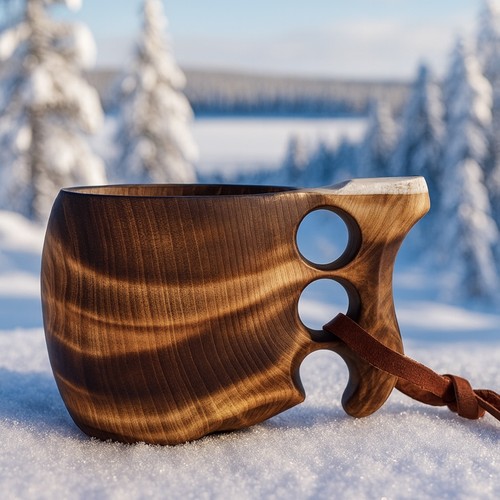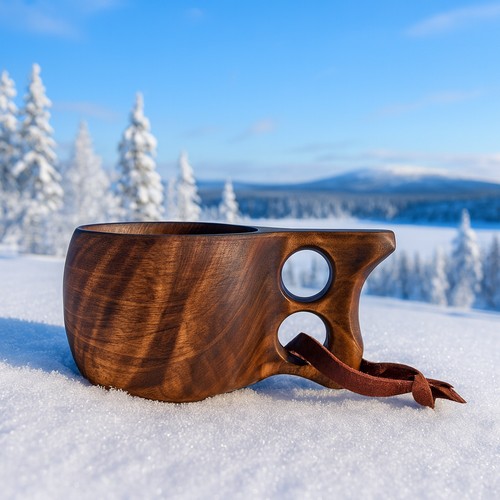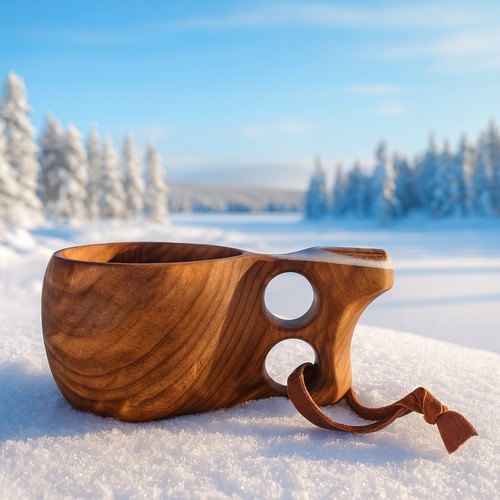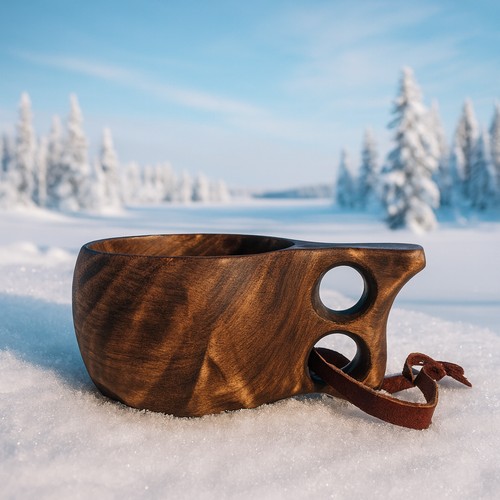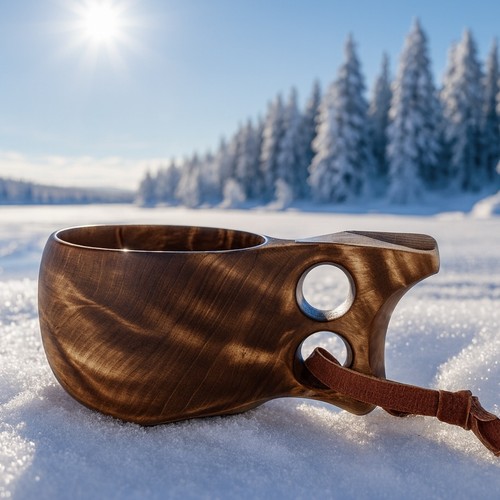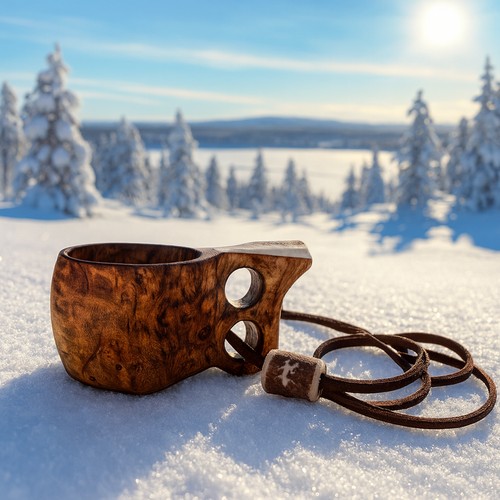How to recognize a traditional kuksa from an imitation?
In this article, discover the essential criteria to recognize a kuksa made in accordance with the traditions of Lapland.

Alexis Le Baron

A kuksa, much more than a wooden cup
A kuksa is not a simple cup; it is a wooden cup that holds an important place in Lapland traditions. It inherits ancestral know-how and was conceived many years ago to accompany every outing in the great outdoors, in summer as in winter.
Today, there are many cups in the kuksa style, but these are imitations that do not respect the wood, the traditions, or the craftsmanship.
A Lapland heritage passed down from generation to generation
The kuksa is an everyday emblematic object of the Sami, the indigenous people who live in Lapland: a vast region covering northern Finland, Sweden and Norway.
For centuries these peoples have carved wooden objects, including kuksas, to accompany them in outdoor life: hot drinks by a wood fire, hiking, fishing, hunting or foraging.
Today, kuksas are hikers' best friends. They are sturdy, hard-wearing and durable.
They also make it easy to drink hot beverages, as they do not burn the lips or the hands and retain heat in cold weather.
It is preferable to buy a high-quality kuksa to:
- Extend the kuksa's lifespan
- Ensure better long-term durability
- Benefit from quality finishing
- Drink from quality wood free of chemicals or toxins
The 6 essential signs of a traditional kuksa
1. The salty taste during initial uses
A genuine kuksa, crafted in the traditional way, will have a slight salty taste at first. It's a natural phenomenon related to how the wood is worked.
During production, kuksas are boiled for 5 hours in salted water to:
- Tighten the wood fibers
- Reduce the risk of cracking
- Make the kuksa more resistant to humidity changes
Salt penetrates slightly into the wood and hardens it, which is why a salty taste is present during the first uses. It is an essential step of traditional Lappish craftsmanship.
This salty taste can be off-putting at first, but it fades quickly and is part of the traditional Finnish experience.
Moreover, if you don't use your kuksa for a long period, small salt crystals may appear on the wood.
This is actually one of the few things that can really indicate the authenticity of your kuksa.
2. A precious wood: the birch burl
The wood traditionally used to make a kuksa is the "pahka" in Finnish or birch burl. It is a growth on the tree that is found on the trunk or branches. The Masur birch wood from Karelia is also commonly used to make kuksas, because it is a typical wood of Lapland: it only grows in harsh climates with very large temperature variations.
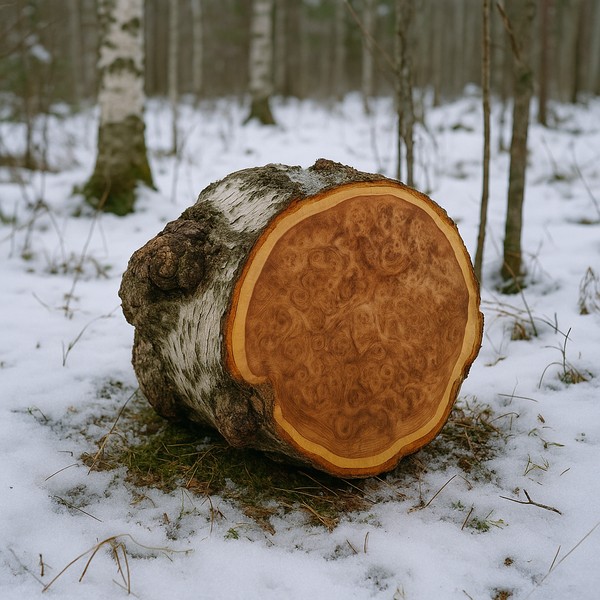
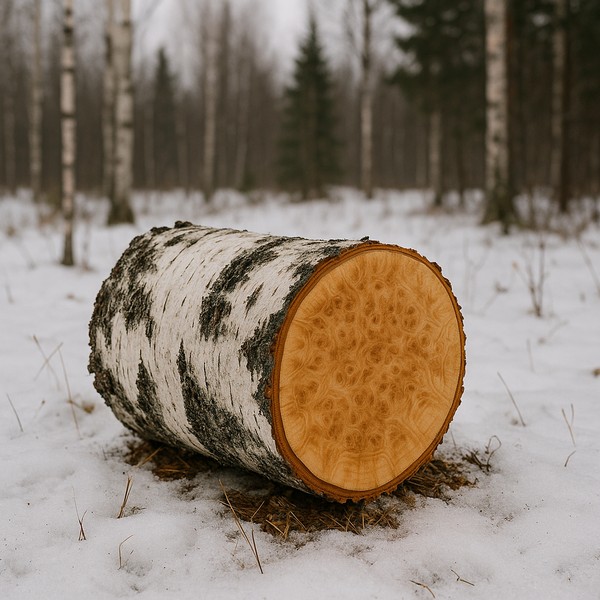
An ordinary wooden cup or a kuksa imitation will be made from acacia, bamboo or rubberwood: light-colored woods with a uniform grain (indicating their industrial manufacture). These woods can cause stains and damage the cup, have a shorter lifespan and durability, get dirty more easily, and may not retain the heat of the beverage.
Immerse yourself in the essence of Finnish craftsmanship as you explore the history and making of this traditional cup. By subscribing, you'll receive information about kuksa once a week.
3. Unique natural patterns in the wood
Each traditional kuksa displays lively patterns: knots, curves, marbling. These nuances cannot be reproduced by a machine or a mold.
If a cup looks too smooth, too uniform, or lacking depth, it is probably just a simple wooden cup, a kuksa imitation.
Here is a very good example: in the photo on the left you have a traditional kuksa made from birch burl. And in the photo on the right, you have a cup made in China by machines from rubberwood.

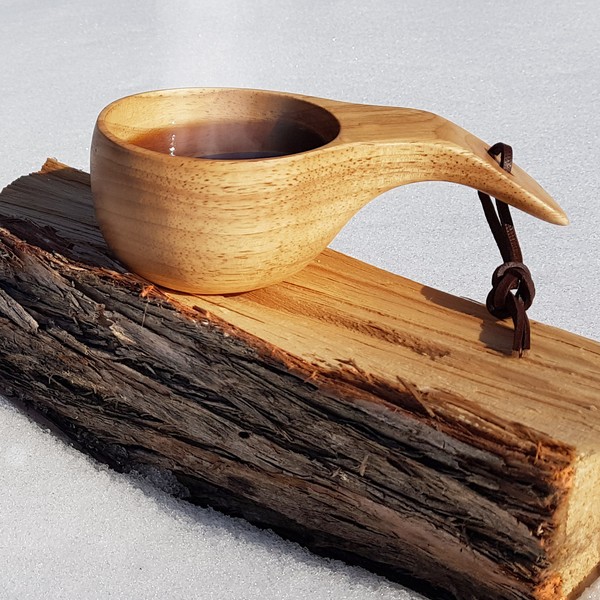
4. 100% handmade production
Traditionally, to make a kuksa you have to carve it entirely by hand with carving knives, but this used to take several weeks to make a cup (including drying time). Today, craftsmen in Lapland combine machines and handwork to reduce the manufacturing time by several days. Here are some explanations:
- Cut the birch burl with a machine to form the cup
- Boil the cup in a salt bath for 5 hours
- Dry the cup for 7 days
- Sand the cup manually to give it a nice shape and a smooth surface
- Soak the cup in coffee for a few minutes to give it a nice dark color, reveal the wood grain, and make the wood less sensitive to moisture
- Add reindeer horn finishes manually or not
- Manually oil the cup with a natural, edible oil
Below is an image gallery showing this long process.
In contrast, an imitation kuksa cup will be entirely made with machines, on an assembly line, or even molded from a wood-and-plastic composite.
5. A maker's mark or artisan's signature
Some artisans in Lapland place their signature or initials on the bottom of the cup or on the back of the handle. However, this is not necessarily a guarantee of quality; it can be a sign of authenticity.
6. A natural color, naturally luminous and oiled
Birch burl wood naturally has a slight, almost satin sheen that reflects light thanks to its dense, wavy grain.
This wood color has nothing to do with the shiny, smooth look of an industrial varnish:
- A traditional kuksa is oiled, never varnished
- Its highlights come from the wood itself, not from a coating
- The surface remains soft and natural, without a "plastic" effect
A kuksa whose surface is very shiny, varnished or uniformly smooth is not traditional; it is most likely an imitation.
You can see in the photo below the difference between a wooden cup made in China (top) and a traditional kuksa handmade by a Finnish craftsman (bottom).

Traditional Kuksa or ordinary wooden cup? The essential comparison
| Critère | Kuksa traditionnelle | Tasse en bois ordinaire |
|---|---|---|
Bois | Loupe de bouleau | Acacia, bambou, bois clair et lisse |
Finition | Huilage naturel | Vernis ou résine |
Fabrication | Sculptée à la main et assisté par les machines | Machine ou moule |
Durabilité | 20 ans et plus | 1 à 3 ans |
Usage | Randonnée, nature | Décoration, usage léger |
Counterfeits and common pitfalls
Nordic design is increasingly common and imitations are widespread. Here are some signs to help you tell them apart:
- Cheap cup: price under 30 €
- Smooth, light, and uniform wood
- Glossy varnish
- Absence of wood grain
- Perfectly symmetrical shape
A traditional kuksa requires rare, high-quality wood and a lot of work: it cannot cost just a few euros.
Our Customers' Favorite Kuksa Cups
Durable, lightweight and timeless, the Kuksa is perfect for those seeking to combine tradition, nature, beauty, and functionality.
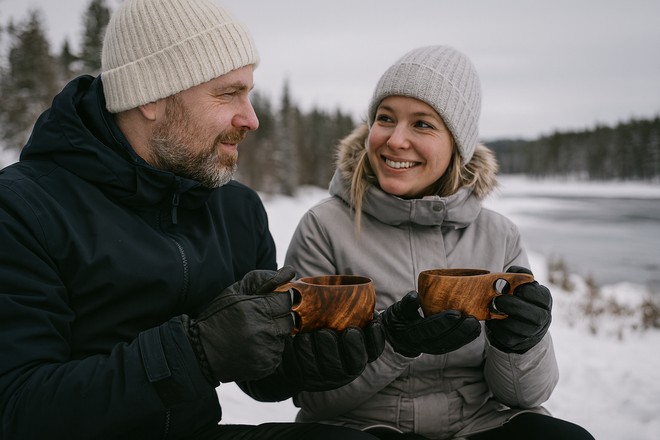
Unique wooden mugs for unforgettable moments
Start shopping now 🌿
Come and discover our wooden tableware from Finland. Handmade tableware that will accompany young and old alike for years to come!
Would you like to learn more about kuksa?
If you're passionate about kuksa, these articles should also interest you.
Maintenance
How to care for your kuksa?Discover ways to extend the life of your kuksa and the four mistakes to avoid.

Anne-Laure Compain
Creators of the Kuksa
The origin of the kuksa in the heart of the Sami peopleWe are talking about the original creators of the kuksa: the Sami people, an indigenous people of northern Scandinavia.

Anne-Laure Compain
TYPES OF WOOD
Which wood should be used to make a kuksa?The traditional kuksa is made of birch burl, but it can be carved in other woods !

Anne-Laure Compain

Anne-Laure Compain

Anne-Laure Compain

Anne-Laure Compain
Subscribe to our newsletter and receive your discount code in your mailbox!


